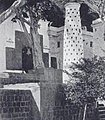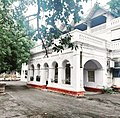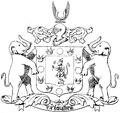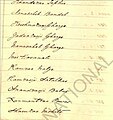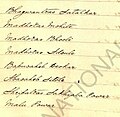Dewas Junior
History
The original state was founded in 1728 by Jivaji Rao, from the Puar clan of Marathas who together with his older brother (Tukoji) had advanced into Malwa with Peshwa Baji Rao, as part of the Maratha conquest.
The brothers divided the territory among themselves; their descendants ruled as the junior and senior branches of the family. After 1841, each branch ruled his own portion as a separate state, though the lands belonging to each were intimately entangled; in Dewas, the capital town, the two sides of the main street were under different administrations and had different arrangements for water supply and lighting.
The Junior branch had an area of 440 sq mi (1,100 km) and had a population of 54,904 in 1901. Both Dewas states were in the Malwa Agency of the Central India Agency. After India's independence in 1947, the Maharajas of Dewas acceded to India, and their states were integrated into Madhya Bharat, which became a state of India in 1950. In 1956, Madhya Bharat was merged into Madhya Pradesh state.
Dewas Junior Darbar (Court) was composed of Sardars, Mankaris, Istamuradars, Thakurs and Jagirdars.
-
An old photograph of Goddess Chamunda Mata's Temple on Dewas Tekri (Hill).
-
The Old Palace (Rajwada) of Dewas Junior.
-
The Durga Bagh Palace, Dewas Junior State.
-
Shree Lakshmi Narayan Bhawan Club, Dewas Junior State.
-
Shree Narayan Tower, Dewas Junior State. The Clock Tower is named after HH Raja Srimant Narayanrao (Dada Sahib) Puar of Dewas Junior State.
-
The Gate at Shree Malhar, The Residence of His Holiness Shri Shilnath Maharaj.
-
The Law Courts, Dewas Junior State.
-
Dewas Collectorate Building (originally known as Lakshmi Niwas Palace of Dewas Junior). This was illegally demolished by the local administration in March 2023, despite an ongoing case and strong opposition by the citizens of Dewas.
-
Dewas Junior Coat of Arms
-
1890 List of Dewas Junior Sardars & Mankaris Page 01
-
1890 List of Dewas Junior Sardars & Mankaris Page 02
-
1890 List of Dewas Junior Sardars & Mankaris Page 03
-
1890 List of Dewas Junior Sardars & Mankaris Page 04
Rulers




| Title | Part of | Start of reign | End of reign | Name |
|---|---|---|---|---|
| Raja | Maratha Empire | 1728 | 15 Aug 1774 | Jivaji Rao Puar "Dada Sahib" (d. 1774) |
| 15 Aug 1774 | 2 Dec 1790 | Sadashiv Rao I Puar (d. 1790) | ||
| 2 Dec 1790 | 1817 | Rukmangad Rao Puar (b. 17.. – d. 1817) | ||
| 1817 | 1818 | Anand Rao Puar "Rao Sahib" (d. 1840) | ||
| British protectorate | 1818 | 1840 | ||
| 1840 | 12 May 1864 | Haibat Rao Puar (d. 1864) | ||
| 12 May 1864 | 19 Jan 1892 | Narayan Rao Puar "Dada Sahib" (b. 1860 – d. 1892) | ||
| 12 May 1864 | 1877 | Yamuna Bai Sahib -Regent + Rao Bahadur R.J. Bhide (Superintendent) | ||
| 9 Jan 1892 | 1 Jan 1918 | Malhar Rao Puar "Bhava Sahib" (b. 1877 – d. 1934) (from 1 Jan 1917, Sir Malhar Rao Puar) | ||
| 19 Jan 1892 | 10 Aug 1913 | Lala Bisheshas Nath – Regent | ||
| Maharaja | 1 Jan 1918 | 4 Feb 1934 | Sir Malhar Rao Puar "Bhava Sahib" (s.a.) | |
| 4 Feb 1934 | 2 Dec 1943 | Sadashiv Rao II Puar "Khase Sahib" (b. 1887 – d. 1943) | ||
| 2 Dec 1943 | 15 Aug 1947 | Yeshwant Rao Puar "Bhau Sahib" (b. 1905 – d. 1965) (from 14 Aug 1947, Sir Yeshwant Rao Puar) |
Colonel HH Maharaja Sir Yeshwant Rao Puar had two daughters, 'Durgaraje' (d/o Padmaraje) who married into the Sardar Phalke family of Gwalior and 'Udayaraje' (d/o Maneka Raje) who married the Raja of Prayagpur.
List of rulers
Rulers
The ruler is a titled 'Maharaja' with respect to 15 gun salute.
| Name | Term Began | Term Ended | |
|---|---|---|---|
| 2 | Dewas Junior State Council | 1965 | - |
| 4 | Dewas Junior State Council with S Parmar | 2024 | - |
See also
References
- ^ Meyer, William Stevenson, Sir; Burn, Richard, Sir; Cotton, James Sutherland; Risley, Sir Herbert Hope. Imperial Gazetteer of India, v. 11. p. 278.
{{cite book}}: CS1 maint: multiple names: authors list (link) - ^ Mayer, Adrian C. (1960). Caste and Kinship in Central India: A Village and Its Region: International library of sociology and social reconstruction. University of California Press. p. 13. ISBN 9780520017474. Retrieved 8 September 2012.
- ^ Lethbridge, Sir Roper (1893). The golden book of India: a genealogical and biographical dictionary of the ruling princes, chiefs, nobles, and other personages, titled or decorated, of the Indian empire. Macmillan. p. 116. Retrieved 8 September 2012.
- ^ One or more of the preceding sentences incorporates text from a publication now in the public domain: Chisholm, Hugh, ed. (1911). "Dewas". Encyclopædia Britannica. Vol. 8 (11th ed.). Cambridge University Press. p. 137.
- ^ Madan, T.N. (1988). Way of Life: King, Householder, Renouncer : Essays in Honour of Louis Dumont. Motilal Banarsidass. p. 129. ISBN 9788120805279. Retrieved 4 July 2015.
- ^ Russell, Robert Vane (1916). "Pt. II. Descriptive articles on the principal castes and tribes of the Central Provinces".
